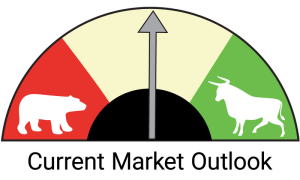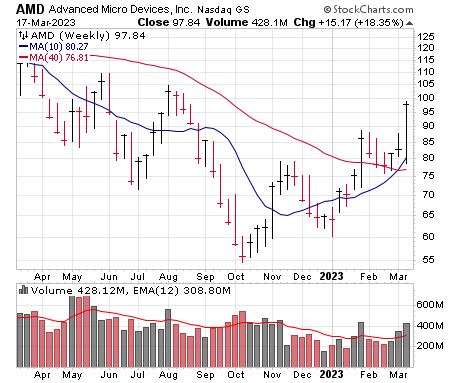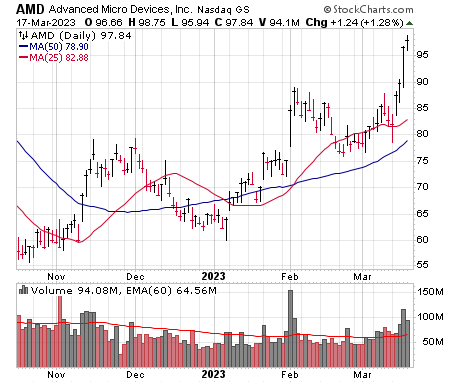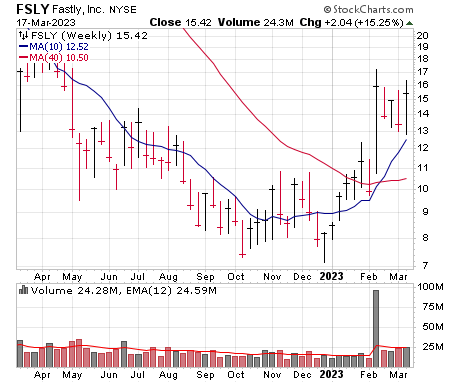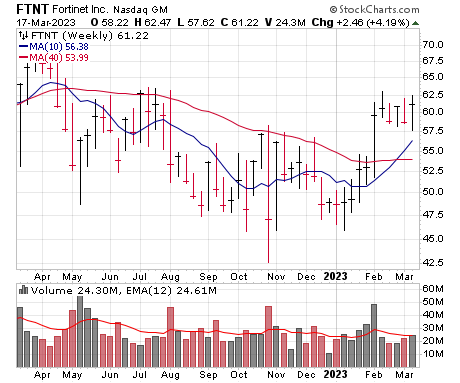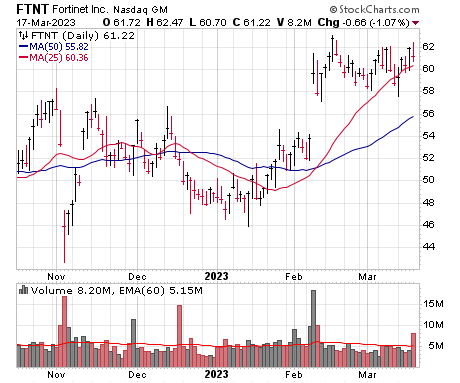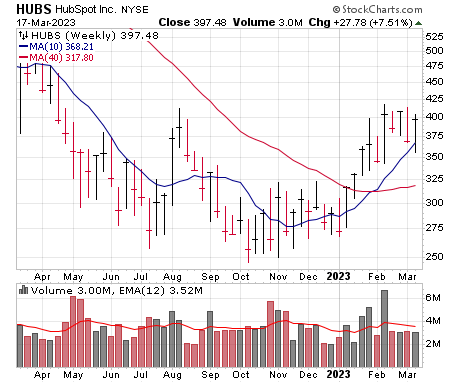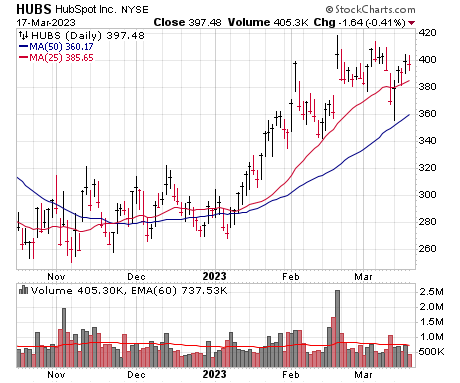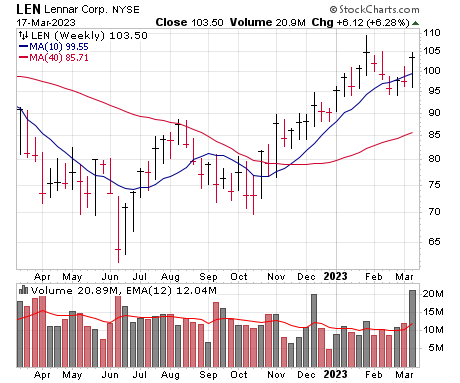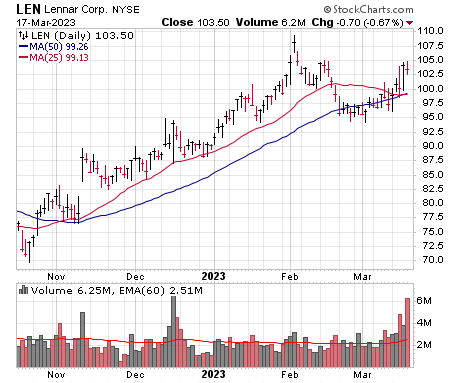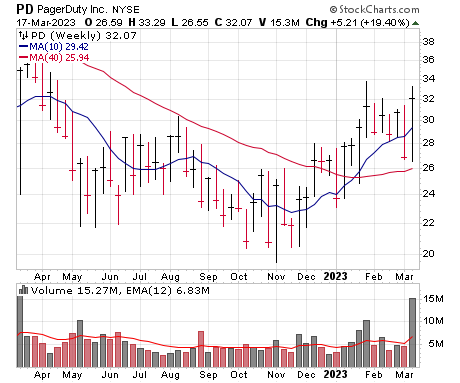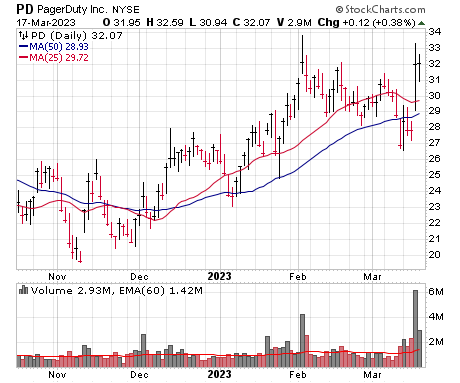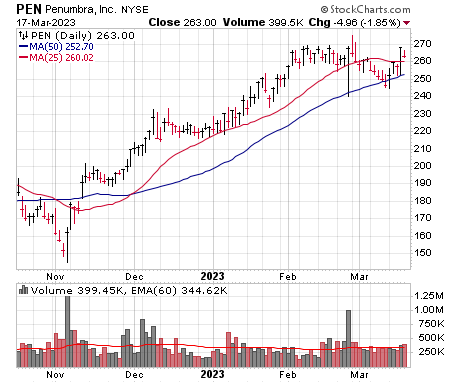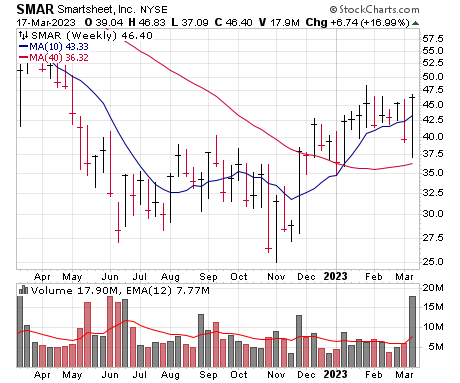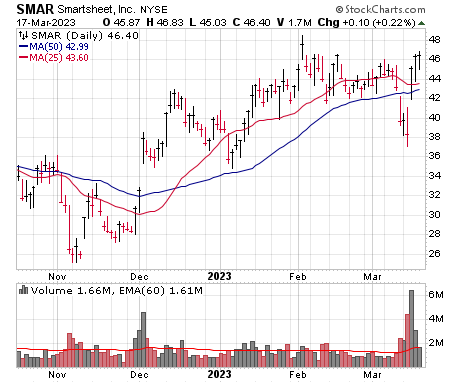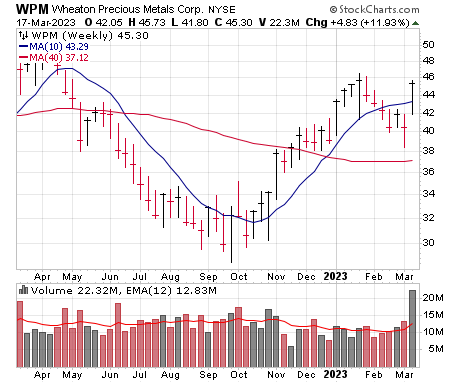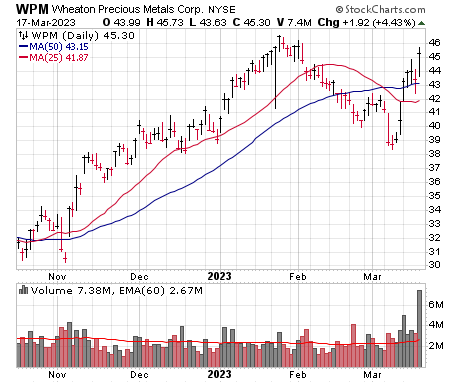Growth OK, Everything Else Not
The market remains mostly weak and very news-driven as the banking crises carries on; the intermediate-term trend of most stocks and sectors are pointed down, and because we’re not ones to catch falling knives, we continue to advise a cautious stance. The one meaningful ray of light we’re seeing is the resilience of big-cap indexes (S&P and Nasdaq were actually up last week) in general, and many growth stocks in particular, including a bunch of recent Top Ten names—lots of growth titles are holding up in fine fashion, which isn’t normally something you see at the front-end of a sustained decline. That’s encouraging, though it doesn’t outweigh the other factors mentioned and, as written before, these financial air pockets tend to have some reverberations as investors figure out how many cockroaches are in the kitchen. All in all, we’ll keep our Market Monitor at a level 5, holding a good chunk of cash while we look for signs the buyers are stepping up.
As you’d expect, this week’s list is heavy on the growth side of the equation, though it also has some interest-rate sensitive names as well. Our Top Pick is Fortinet (FTNT), a well-situated cybersecurity play that’s trading tightly despite the market’s shenanigans. Keep it small and aim for dips.
| Advanced Micro Devices (AMD) |
| Fastly (FSLY) |
| Floor & Décor (FND) |
| Fortinet (FTNT) ★ Top Pick ★ |
| HubSpot (HUBS) |
| Lennar (LEN) |
| PagerDuty (PD) |
| Penumbra (PEN) |
| Smartsheet (SMAR) |
| Wheaton Precious Metals (WPM) |
Stock 1
Advanced Micro Devices (AMD)
Price | Buy Range | Loss Limit |
Why the Strength
Semiconductor outfit Advanced Micro has quite a few tailwinds due to the large number of markets it serves, but perhaps none are as powerful as the secular growth trends in high-performance computing (HPC) and generative artificial intelligence (AI). On the HPC front, the company’s data center-class MI300 superchip is due to be released later this year and has been selected to power El Capitan—the world’s fastest supercomputer—at the Lawrence Livermore National Lab (the firm’s chips also power more than 100 more of the world’s fastest supercomputers). On the AI front, AMD sees a “huge opportunity” that it says will expand the need for MI300. (Indeed, AMD is already working with several big cloud vendors to qualify MI300 for AI workloads, and management expects the superchip to be a big sales growth contributor starting next year.) Not all is rosy: Demand is weakening on the PC and gaming fronts, though AMD is seeing higher share gains in its data center segment, along with server and embedded system market offerings like EPYC and Genoa (for cloud, enterprise and HPC workloads). Elevated sales from the company’s data center and embedded segments offset weaker client and gaming demand in Q4, pushing total revenue up 16% from a year ago. Per-share earnings of 69 cents beat estimates by a mile, driven by strong sales of EPYC server processors, though were down from last year. Indeed, for Q1, the top brass expects sales to be 10% lower, driven by lower expected client and gaming segment sales; however, it sees “substantial” new revenue opportunities ahead from the company’s expanded breadth of data center products. Wall Street agrees; after a reset during the next couple of quarters, sales should materially increase in the second half of this year and well into 2024.
Technical Analysis
AMD hit a long-term peak in late 2021, then plunged with all technology stocks last year. It wasn’t until October that the dust settled and shares hit their nadir at 56 (down 66%). After an initial bounce into December, the stock pulled back to 60 (establishing a higher low), which led to the early-year surge to 89. Even better was the recent action, with a controlled dip into February and with AMD actually gaining ground as the market has sold off, including last week’s surge to multi-month highs. Today’s dip was normal, and we’ll set our entry range a bit down from here.
| Market Cap | $158B | EPS $ Annual (Dec) | ||
| Forward P/E | 49 | FY 2021 | 2.79 | |
| Current P/E | 27 | FY 2022 | 3.50 | |
| Annual Revenue | $23.6B | FY 2023e | 2.00 | |
| Profit Margin | 19.9% | FY 2024e | 3.42 | |
| Qtrly Rev | Qtrly Rev Growth | Qtrly EPS | Qtrly EPS Growth | |
| ($B) | (vs. yr-ago-qtr) | ($) | (vs. yr-ago-qtr) | |
| Latest qtr | 5.60 | 16% | 0.69 | -25% |
| One qtr ago | 5.57 | 29% | 0.67 | -8% |
| Two qtrs ago | 6.55 | 70% | 1.05 | 67% |
| Three qtrs ago | 5.89 | 71% | 1.13 | 117% |
Weekly Chart | Daily Chart |
Stock 2
Fastly (FSLY)
Price | Buy Range | Loss Limit |
Why the Strength
Fastly is a top cloud provider whose content delivery network (CDN) accelerates the distribution of videos, images and other online content by storing websites’ cached copies on its “edge” servers (located near the physical location of the user), while also protecting against cyberattacks. Its platform supports thousands of well-trafficked websites, including Yelp, Wayfair, Foursquare and many other big names. Growth has slowed since the post-pandemic boom, but a stellar Q4 earnings report that exceeded estimates—and the top end of the company’s own guidance—is the main reason for the strength. The company set records for both quarterly and yearly revenue, with Q4 sales of $119 million and 2022 sales of $433 million increasing 22% from a year ago. The Q4 per-share loss of eight cents also beat estimates by five cents and continued the narrowing trend. Very impressive is that once clients sign up for Fastly, they stay on and eventually buy more services—last year, the revenue retention rate was a ridiculous 99.2% (i.e., $99 out of $100 of customer spend stuck around, net-net), remaining at the same nosebleed levels from 2021, while same-customer revenue growth increased 23% in the quarter. It’s not a lightning-fast growth story anymore (the client count was up just 1% sequentially in Q4), but even so, management provided upbeat guidance that called for Q1 revenue to increase 14% and full-year sales to increase 15% at the midpoint. Better, yet, this looks like more than a one-year thing—Wall Street sees mid-teens annual revenue growth for the next few years while earnings lift out of the red and cash flow improves.
Technical Analysis
FSLY was one of the hottest post-pandemic names, soaring from 26 to 128 in just a few months after the crash. But then it gave all that up and more, with the stock imploding all the way to 7 (!) last October. A couple of months of bottoming ensued, but shares began to come alive after the calendar flipped and then (most important) had a massive-volume gap up on earnings (biggest weekly volume in nearly two and a half years). The rest since then has been volatile, but normal, with FSLY nearly tagging new closing highs last Thursday. If you’re game, dips toward the 25-day line would be tempting.
| Market Cap | $1.90B | EPS $ Annual (Dec) | ||
| Forward P/E | N/A | FY 2021 | -0.48 | |
| Current P/E | N/A | FY 2022 | -0.59 | |
| Annual Revenue | $433M | FY 2023e | -0.26 | |
| Profit Margin | N/A | FY 2024e | -0.10 | |
| Qtrly Rev | Qtrly Rev Growth | Qtrly EPS | Qtrly EPS Growth | |
| ($M) | (vs. yr-ago-qtr) | ($) | (vs. yr-ago-qtr) | |
| Latest qtr | 119 | 22% | -0.08 | N/A |
| One qtr ago | 109 | 25% | -0.14 | N/A |
| Two qtrs ago | 103 | 21% | -0.23 | N/A |
| Three qtrs ago | 102 | 21% | -0.15 | N/A |
Weekly Chart | Daily Chart |
Stock 3
Floor & Décor (FND)
Price | Buy Range | Loss Limit |
Why the Strength
Floor & Décor has always had a great growth story: It’s taking huge share in the hard flooring sector, offering all sorts of floor tiles, laminates, wall tile, natural stone and much more via 191 warehouse-type locations as well as six design studios. Big picture, more people are going toward hard surfaces (less carpet, etc.), which obviously helps, but the firm’s big advantage is its inventory, with its warehouses carrying 1,400 or so products compared to a couple hundred or so for its competitors, which attracts both DIY’ers and contractors who want things right quick. When you throw in an ambitious cookie-cutter expansion plan (it’s been expanding the store count by 10% to 20% annually; for 2023, it anticipates growing the base by 17% or so) and a history of same-store sales growth and Floor & Décor has been a great growth outfit. However, the firm has faced headwinds of late—costs have gone way up (mostly shipping and logistics) and of course, the housing market has slowed; Floor & Decor has passed on those costs to customers, which has boosted sale prices but, in Q4, both factors contributed to a 10% decline in actual transactions and why 2023 guidance was just so-so. Still, as with most housing-related issues, investors are looking ahead—the top brass sees same-store sales turning up late this year, and the recent dip in mortgage rates (good for the sector) and likely easing of cost pressures have many thinking guidance will prove conservative. All in all, Floor & Décor is a great long-term growth story that, after a mini-hiccup early this year, should get back on track.
Technical Analysis
FND topped in late 2021 with everything else and fell from around 145 to 60 by the middle of last year. The summer rally didn’t stick, but shares etched some higher lows toward the end of the year before racing toward resistance near 100 last month. Now FND has backed off with the market, but the 50-day line is offering some support and the stock actually saw some higher-volume buying last week. If you’re interested, you could nibble on further strength and use a stop near the recent lows.
| Market Cap | $9.71B | EPS $ Annual (Dec) | ||
| Forward P/E | 34 | FY 2021 | 2.44 | |
| Current P/E | 33 | FY 2022 | 2.75 | |
| Annual Revenue | $4.27B | FY 2023e | 2.70 | |
| Profit Margin | 6.6% | FY 2024e | 3.42 | |
| Qtrly Rev | Qtrly Rev Growth | Qtrly EPS | Qtrly EPS Growth | |
| ($B) | (vs. yr-ago-qtr) | ($) | (vs. yr-ago-qtr) | |
| Latest qtr | 1.05 | 15% | 0.64 | 45% |
| One qtr ago | 1.10 | 25% | 0.70 | 17% |
| Two qtrs ago | 1.09 | 27% | 0.76 | 4% |
| Three qtrs ago | 1.03 | 31% | 0.65 | -4% |
Weekly Chart | Daily Chart |
Stock 4
Fortinet (FTNT) ★ Top Pick ★
Price | Buy Range | Loss Limit |
Why the Strength
Many analysts expect cloud and software spending to slow this year due to a challenging economic environment, but cybersecurity is likely to outperform, fueled by the accelerating threat of cyberattacks, the demands of hybrid work and increased data privacy regulations. Fortinet occupies a top spot in the cybersecurity software space by using artificial intelligence (AI) and machine learning (ML) to stay ahead of evolving threats. (The company’s FortiNDR, for instance, detects threats that may slip past traditional security solutions by using both ML and AI.) Fortinet’s AI-based offerings have attracted a massive customer base of 635,000 (including most Fortune 500 companies), and the firm has a leading position in the firewall market with FortiGate being the world’s most deployed network firewall. Estimate-beating Q4 earnings of 44 cents per share, up 76% from a year ago, and sales of $1.3 billion (up 33%), are reasons for the stock’s resilience, with both numbers driven by strong demand for the firm’s core and enhanced (newer) technology platforms; the results prompted a major Wall Street institution to boost its price target (another reason for the strength). Management said it continues to gain market share in the service security industry and boasted eye-opening product revenue growth of 42% in that segment during Q4. Service revenue, meanwhile, was up almost 30%, driven by the strength of its security subscriptions. Billings (a leading indicator) of $1.7 billion also hit a record in Q4 and passed the $5 billion mark for all of 2022, with both increasing 30%, and the company hit an additional record by adding 6,200 new logos in Q4. Looking ahead, Fortinet expects the growth to continue, guiding for Q1 EPS of about 28 cents a share (up 50% if realized) and midpoint revenue of $1.2 billion (up 25%).
Technical Analysis
FTNT had a great post-pandemic run to the mid-70s in late 2021 and then fell on hard times—though, compared to most cybersecurity peers, the damage wasn’t that bad. Yes, the stock did fall about 45% from high to low, but for the most part, the trading action was more sideways than down. And then FTNT changed character late last year, with some tightness near 50 and a nice pre- and post-earnings rally into February—with the latest batch of tight trading coming on low volume and standing in contrast to the broad market. We’re OK with a nibble here or (preferably) on dips.
| Market Cap | $48.0B | EPS $ Annual (Dec) | ||
| Forward P/E | 52 | FY 2021 | 0.80 | |
| Current P/E | 52 | FY 2022 | 1.19 | |
| Annual Revenue | $4.41B | FY 2023e | 1.17 | |
| Profit Margin | 27.3% | FY 2024e | 1.45 | |
| Qtrly Rev | Qtrly Rev Growth | Qtrly EPS | Qtrly EPS Growth | |
| ($B) | (vs. yr-ago-qtr) | ($) | (vs. yr-ago-qtr) | |
| Latest qtr | 1.28 | 33% | 0.44 | 76% |
| One qtr ago | 1.15 | 33% | 0.33 | 65% |
| Two qtrs ago | 1.03 | 29% | 0.24 | 26% |
| Three qtrs ago | 0.95 | 34% | 0.19 | 19% |
Weekly Chart | Daily Chart |
Stock 5
HubSpot (HUBS)
Price | Buy Range | Loss Limit |
Why the Strength
Most of the software leaders of the last bull cycle aren’t likely to rejoin the leadership ranks, but HubSpot could be an exception as it still has many characteristics of a winner. HubSpot used to be known for its inbound sales and marketing offerings, and those remain a big draw today for tons of small- and mid-sized clients. But as time has passed, the company has morphed into a CRM platform provider, offering an all-in-one solution so that customers can standardize their sales and marketing, content management, operations and customer service (along with all the data, reporting and even payment-related back-end services these firms need) in one place. All told, HubSpot is thinking big, aiming to be the #1 platform provider for “scaling companies” that are looking to thrive online. After a boom during the pandemic, sales growth is likely to slow some (analysts see 20%-ish growth this year and next), but a big reason for the strength is that the company has decisively turned the corner on the bottom line, with earnings booming and cash flow very healthy—analysts see earnings up 46% this year and another 30% next (both likely conservative; the Q4 bottom line topped estimates by 36%), while free cash flow totaled around $3.75 per share in the past 12 months. HubSpot has north of 167,000 customers (up 24% from a year ago), though it still thinks it’s just scratching the surface of its potential, with a total market of $45 billion or so that’s growing steadily each year. Long story short, HubSpot has the look of an emerging blue chip of sorts, with solid top- and bottom-line growth likely for many years as it attracts more smaller fish to its platform.
Technical Analysis
After a giant run, HUBS was taken apart after topping in late 2021, falling from 860 to 260 by June of last year. But that was effectively the low, with the 245 to 300 area offering support many times in the months that followed, and then shares perked up on repeated big-volume weeks once the calendar flipped, highlighted by a post-earnings move in mid-February. Best of all is that HUBS is holding up well since then, with a dip near the 50-day line quickly being gobbled up by buyers. It’s not for the faint of heart, but we’re OK nibbling here with a stop near the recent low.
| Market Cap | $19.6B | EPS $ Annual (Dec) | ||
| Forward P/E | 94 | FY 2021 | 1.82 | |
| Current P/E | 144 | FY 2022 | 2.91 | |
| Annual Revenue | $1.73B | FY 2023e | 4.23 | |
| Profit Margin | 12.1% | FY 2024e | 5.50 | |
| Qtrly Rev | Qtrly Rev Growth | Qtrly EPS | Qtrly EPS Growth | |
| ($M) | (vs. yr-ago-qtr) | ($) | (vs. yr-ago-qtr) | |
| Latest qtr | 470 | 27% | 1.11 | 91% |
| One qtr ago | 444 | 31% | 0.69 | 38% |
| Two qtrs ago | 422 | 36% | 0.44 | 2% |
| Three qtrs ago | 396 | 41% | 0.54 | 74% |
Weekly Chart | Daily Chart |
Stock 6
Lennar (LEN)
Price | Buy Range | Loss Limit |
Why the Strength
Banking problems are certainly negative for the economy, with less lending/more regulations from regional banks likely to crimp activity in the months to come. But for interest rate-sensitive sectors, it could actually help, especially when you consider the market had been discounting higher-for-longer- rates that would crimp activity. That’s the main reason why homebuilders have been percolating, and Lennar (one of the big national builders) is one of the best-acting names. The other reason for the group’s strength is that, despite the huge backup in mortgage rates and affordability, business has been holding in there—Lennar’s February quarter, released last week, did show earnings down 21% from a year ago, but the figure topped estimates by more than 50% ($2.12 vs. $1.56 expected) as new orders in units (down 10%) and volume (down 18%) didn’t fall off a cliff, while profit margins (9.5%) were solid, too. The end result is that big investors are thinking that, if the economy doesn’t totally go belly up, we may have seen (or will soon see) the bottom in housing, which means Lennar’s earnings are likely to remain elevated this year (around $10 per share this fiscal year, ending in November) and resume their climb later this year as mortgage rates back off and (importantly) supply remains crimped. Throw in a very solid balance sheet here (liabilities are just one-third of assets) and some modestly shareholder-friendly actions (dividend yield 1.4%; bought back 0.7% of shares last quarter) and Lennar has a shot to remain in favor in the months to come.
Technical Analysis
LEN got hit with its sector in the first half of last year, but after etching a higher low in October, it enjoyed a solid, persistent uptrend that recouped most of the decline. It and its peers finally did crack some intermediate-term support as the market’s correction deepened, but as stocks really keeled over the past two weeks, LEN has actually rallied, first on lower rates and then after the quarterly report. If you want in, we suggest aiming to buy on a push above 105 with a stop in the upper 90s.
| Market Cap | $30.0B | EPS $ Annual (Nov) | ||
| Forward P/E | 10 | FY 2021 | 12.68 | |
| Current P/E | 6 | FY 2022 | 17.91 | |
| Annual Revenue | $34.0B | FY 2023e | 9.95 | |
| Profit Margin | 9.5% | FY 2024e | 10.86 | |
| Qtrly Rev | Qtrly Rev Growth | Qtrly EPS | Qtrly EPS Growth | |
| ($B) | (vs. yr-ago-qtr) | ($) | (vs. yr-ago-qtr) | |
| Latest qtr | 6.49 | 5% | 2.12 | -21% |
| One qtr ago | 10.20 | 21% | 5.02 | 15% |
| Two qtrs ago | 8.93 | 29% | 5.18 | 58% |
| Three qtrs ago | 8.36 | 30% | 4.69 | 59% |
Weekly Chart | Daily Chart |
Stock 7
PagerDuty (PD)
Price | Buy Range | Loss Limit |
Why the Strength
PagerDuty makes digital operations management software, collecting data from virtually any software-enabled system or device and using machine learning to correlate and process information as well as to mine for inefficiencies and potential software problems. PagerDuty uses this ability to offer four main types of products for corporate customers: Incident response to determine the source of a digital problem; automation applications for IT stuff that makes disparate systems work better together; event intelligence which crunches billions of data points to try and identify trends; and for customer service, to make client-facing operations more responsive. The company’s offerings are pitched as a way to digitally gather the dozens or hundreds of database, security and operations software packages that businesses use under one tent. Management finds that once a corporation starts using PagerDuty’s free, entry-level incidence response product, they migrate over the next few years to at least some of its paid products, ranging from $240 to $1,500 per user annually. The proliferation of varied business software apps that firms have to wrangle has made for a fast-growing business: PagerDuty’s Q4 revenue reported last week was up 29% year over year to $101 million. To be fair, management sees this year as full of headwinds, with corporate customers starting to drag their feet on closing orders, a typical reaction seen in economically uncertain times. Still, PagerDuty says Q1 sales will come in at $103 million, a 21% rise. A key to maintaining double-digit growth is expanding its footprint with large businesses, with nearly half the Fortune 500 among its client base. Better yet it looks like the firm has finally moved into the black—analysts see the bottom line lifting to 46 cents a share this year and continuing to grow nicely from there.
Technical Analysis
The past two years for PD have been dominated by bears, with shares surrendering just about half their value in a steady grind downwards. Opportunistic buyers started coming in to close out 2022, and, while shares haven’t been super-strong, PD has managed to re-establish itself over its 40-week line and start eating away at a zone of congestion sitting in the mid-30 area. After a quick dip with the market two weeks ago, buying volume on Q4 results, out last week, was excellent, with weekly volume the strongest seen in a year. It’s going to be choppy, but we’re fine with a nibble here and a stop near the recent lows.
| Market Cap | $2.86B | EPS $ Annual (Jan) | ||
| Forward P/E | 70 | FY 2022 | -0.32 | |
| Current P/E | 799 | FY 2023 | 0.04 | |
| Annual Revenue | $371M | FY 2024e | 0.46 | |
| Profit Margin | 7.2% | FY 2025e | 0.64 | |
| Qtrly Rev | Qtrly Rev Growth | Qtrly EPS | Qtrly EPS Growth | |
| ($M) | (vs. yr-ago-qtr) | ($) | (vs. yr-ago-qtr) | |
| Latest qtr | 101 | 29% | 0.08 | N/A |
| One qtr ago | 94.2 | 31% | 0.04 | N/A |
| Two qtrs ago | 90.3 | 34% | -0.04 | N/A |
| Three qtrs ago | 85.4 | 34% | -0.04 | N/A |
Weekly Chart | Daily Chart |
Stock 8
Penumbra (PEN)
Price | Buy Range | Loss Limit |
Why the Strength
A thrombosis is a blood clot that develops in an artery and is extremely dangerous, as it can obstruct blood flow to major organs. Mechanical thrombectomy devices that use aspiration (typically involving catheters to drain the clots) are one way of addressing the needs of thrombosis patients. This is where medical device maker Penumbra, which is focused on therapies that address a range of diseases that restrict blood flow, enters the picture: The company’s main offering is the Indigo Aspiration System (IAS), a minimally invasive device that can be used to remove blood clots from vessels of the peripheral arterial and venous systems, as well as for the treatment of pulmonary embolisms. (The system uses the Penumbra Engine aspiration source to deliver a nearly pure, continuous vacuum, enabling thrombus removal in blood vessels of various sizes.) More recently, Penumbra is betting that computer-aided aspiration devices that detect clots and blood flow while reducing treatment times are a massive growth opportunity, and the company is doubling down on this technology. Penumbra’s Lightning Flash mechanical thrombectomy system uses a proprietary algorithm to remove large blood clots in the body, including venous thrombus and pulmonary emboli; the device was recently cleared for launch by the FDA (one of the main reasons for the strength) and is expected by analysts to generate as much as $100 million in sales this year alone. In Q4, the company generated revenue of just over $220 million (up 8% from a year ago), with full-year revenue of almost $850 million jumping 13%, while per-share earnings of 16 cents beat estimates by a cent. Looking ahead, management expects to achieve at least $1 billion in revenue in 2023 (up 19%) while earnings are expected to take off on the upside.
Technical Analysis
PEN leveled off for much of 2021 and then got whacked in the first half of last year, falling to a nadir just under 120 in the summer. It wasn’t a smooth ride, of course, but the stock began to repair the damage soon after that, with a higher low in November and then Q3 earnings really changing PEN’s character—after a quick move from 150 to 200, shares rallied nicely to 270 before some sideways, choppy action of late with the market and after Q4 earnings. If you’re OK using a tight stop in the mid-230s, you could start small here.
| Market Cap | $10.0B | EPS $ Annual (Dec) | ||
| Forward P/E | 216 | FY 2021 | 0.69 | |
| Current P/E | 999 | FY 2022 | 0.16 | |
| Annual Revenue | $847M | FY 2023e | 1.22 | |
| Profit Margin | 2.7% | FY 2024e | 2.26 | |
| Qtrly Rev | Qtrly Rev Growth | Qtrly EPS | Qtrly EPS Growth | |
| ($M) | (vs. yr-ago-qtr) | ($) | (vs. yr-ago-qtr) | |
| Latest qtr | 221 | 8% | 0.16 | 60% |
| One qtr ago | 214 | 12% | 0.01 | -92% |
| Two qtrs ago | 208 | 13% | 0.01 | -95% |
| Three qtrs ago | 204 | 21% | -0.01 | N/A |
Weekly Chart | Daily Chart |
Stock 9
Smartsheet (SMAR)
Price | Buy Range | Loss Limit |
Why the Strength
Smartsheet is a software company focusing on collaborative work management (CWM), offering applications and processes for corporate teams to coordinate tasks and project management in real time. Smartsheet offers everything from shared calendars to the ability for non-IT workers to use automation scripts to streamline repetitive tasks across varied software systems. It’s a business that saw growth accelerate nicely during the pandemic in concert with the rise of remote work, but it continues to be strong as businesses weave in permanent distance workers as well as more satellite offices. Even with a slowing of the sales cycle occurring as customers tap the brakes given the current economic headwinds, Smartsheet says revenue should rise 24% this year to around $945 million, with the bottom line quickly approaching breakeven. Beneath the net loss, operating metrics are improving, with the business turning cash flow positive for the first time in Q4, which was reported last week. Smartsheet tallied $16.4 million in free cash flow (11 cents a share) and a non-GAAP net income of $7.4 million as the business showed solid operating leverage. Management says efforts to cut its own costs late last year coupled with the economies of scale from signing larger customers is making the business more efficient. The fastest-growing segment of its customer base are companies that spend $100,000 or more on Smartsheet products. Client count in that group was up 45% year over year to 1,434. Much of the traction comes from premium-priced tiers that offer better security and governance capabilities plus a broader ability to integrate popular customer relationship management systems like Salesforce and other team software platforms such as Jira. Given its leadership position, there’s no reason Smartsheet can’t grow nicely for a long time to come.
Technical Analysis
SMAR showed some oomph in December of last year and rallied decently through January, but it couldn’t really gain traction and, when the banking issues arose, the stock clearly cracked support (forcing us out). But then came Q4 earnings, which gapped the stock up on big volume, creating an intriguing pattern—what we call a “shake and snap,” which basically means the prior move may have knocked out the weak hands and paved the way for higher prices. We’re OK nibbling on minor weakness.
| Market Cap | $6.09B | EPS $ Annual (Jan) | ||
| Forward P/E | N/A | FY 2022 | -0.28 | |
| Current P/E | N/A | FY 2023 | -0.22 | |
| Annual Revenue | $767M | FY 2024e | -0.15 | |
| Profit Margin | N/A | FY 2025e | -0.01 | |
| Qtrly Rev | Qtrly Rev Growth | Qtrly EPS | Qtrly EPS Growth | |
| ($M) | (vs. yr-ago-qtr) | ($) | (vs. yr-ago-qtr) | |
| Latest qtr | 212 | 35% | 0.07 | N/A |
| One qtr ago | 200 | 38% | -0.01 | N/A |
| Two qtrs ago | 187 | 42% | -0.10 | N/A |
| Three qtrs ago | 168 | 44% | -0.18 | N/A |
Weekly Chart | Daily Chart |
Stock 10
Wheaton Precious Metals (WPM)
Price | Buy Range | Loss Limit |
Why the Strength
The Silicon Valley Bank crisis has prompted fresh fears of sustained industry-wide banking crisis for investors, in turn generating increased interest in safe-haven assets like gold. Those worries have also pushed the yellow metal’s price toward $2,000 an ounce for the first time in over a year, which could serve as a catalyst for new exploration and mining activities. After reporting below-average gold production last year, royalty and streaming outfit Wheaton (covered in the January 9 report) is in a strong position to benefit from higher production and pricing. The company recently guided for gold output in 2023 to be 17% higher compared to last year, and for output as a whole, the firm sees average production over the next five years to be about 30% higher than 2022’s tally, while output during the next 10 years should be up nearly 40% from last year’s total. Wheaton’s main focus is on high-quality, high-margin operations with a goal of returning a minimum of 30% of cash flow to its shareholders, and in 2022, the firm cranked out a hefty $740 million in operating cash flow (about $1.65 a share) despite the year’s lower production. Revenue of just over $1 billion in 2022 was 11% lower from 2021 and was 15% lower for Q4, while per-share earnings of 23 cents in the quarter missed estimates by two cents, but this was due mainly to lower sales volumes and lower realized gold prices—trends the company expects will reverse in 2023. Looking ahead, management reported a “healthy appetite” for streaming as a source of capital for the mining industry and Wheaton’s war chest of almost $3 billion should allow it to book some new, attractive streaming and royalty deals. Even so, gold prices will be the big near-term driver, with any new flood of liquidity from the Fed and other central banks likely to keep precious metals prices in favor.
Technical Analysis
WPM tumbled over 40% from its high-water mark of 52 last April, with shares coming to rest at 29 in late September. But the washout paved the way for the stock’s turnaround, which began in November and saw the stock rally to 46.5 in late January. The backing-off phase from there was a bit sharp, but WPM started to find good-volume support two weeks ago and saw huge accumulation last week as the banking issues become more widespread. We’ll set our buy range down a bit if you want in.
| Market Cap | $20.5B | EPS $ Annual (Dec) | ||
| Forward P/E | 39 | FY 2021 | 1.31 | |
| Current P/E | 39 | FY 2022 | 1.12 | |
| Annual Revenue | $1.07B | FY 2023e | 1.16 | |
| Profit Margin | 43.9% | FY 2024e | 1.34 | |
| Qtrly Rev | Qtrly Rev Growth | Qtrly EPS | Qtrly EPS Growth | |
| ($M) | (vs. yr-ago-qtr) | ($) | (vs. yr-ago-qtr) | |
| Latest qtr | 236 | -15% | 0.23 | -21% |
| One qtr ago | 219 | -19% | 0.21 | -30% |
| Two qtrs ago | 303 | -8% | 0.33 | -8% |
| Three qtrs ago | 307 | -5% | 0.35 | -3% |
Weekly Chart | Daily Chart |
Previously Recommended Stocks
| Date | Stock | Symbol | Top Pick | Original Buy Range | 3/20/23 |
| HOLD | |||||
| 9/12/22 | ★ | 48.5-51.5 | 64 | ||
| 3/6/23 | 23-24 | 27 | |||
| 2/13/23 | ★ | 40.5-42.5 | 47 | ||
| 2/27/23 | 38-40 | 38 | |||
| 2/27/23 | ★ | 116-122 | 132 | ||
| 3/6/23 | ★ | 215-222 | 214 | ||
| 2/27/23 | 99-103 | 105 | |||
| 3/13/23 | Dick’s Sporting Goods | DKS | 141-144 | 144 | |
| 3/13/23 | DraftKings | DKNG | 17.3-18.0 | 17 | |
| 3/6/23 | 115-121 | 130 | |||
| 2/27/23 | 159-163 | 161 | |||
| 3/6/23 | 202-208 | 204 | |||
| 11/7/22 | 145-150 | 199 | |||
| 3/13/23 | Frontline | FRO | 14.8-15.2 | 17 | |
| 2/21/23 | 68.5-71 | 67 | |||
| 3/6/23 | 53-55 | 56 | |||
| 2/27/23 | 225-230 | 259 | |||
| 2/27/23 | 180-185 | 190 | |||
| 1/9/23 | ★ | 218-226 | 266 | ||
| 2/6/23 | 54.5-56.5 | 55 | |||
| 3/13/23 | Samsara | IOT | ★ | 18-19 | 18 |
| 11/21/22 | 44-46 | 67 | |||
| 2/27/23 | 94-97 | 99 | |||
| 3/13/23 | TransDigm | TDG | 725-735 | 701 | |
| 8/22/22 | 115-120 | 185 | |||
| 3/13/23 | WW Grainger | GWW | 650-665 | 674 | |
| 12/5/22 | Wynn Resorts | WYNN | 81-84 | 108 | |
| WAIT | |||||
| 3/13/23 | 144-148 | 165 | |||
| 3/13/23 | Meta Platforms | META | 177-182 | 198 | |
| SELL RECOMMENDATIONS | |||||
| 2/21/23 | 49.5-50.5 | 43 | |||
| 1/30/23 | 89-91 | 87 | |||
| 2/6/23 | 218-228 | 205 | |||
| 1/17/23 | 74.5-77 | 81 | |||
| 3/6/23 | 149-154 | 131 | |||
| 1/30/23 | 71-73.5 | 71 | |||
| 3/6/23 | 198-203 | 192 | |||
| 3/6/23 | 6.9-7.3 | 6 | |||
| 2/27/23 | Wesco | WCC | 161-166 | 142 | |
| DROPPED | |||||
| 3/13/23 | 14.5-14.8 | 13 | |||
| 3/13/23 | 54.5-56 | 47 | |||
| (Both FTI and TEX never traded in the buy range and have broken badly) | |||||
The next Cabot Top Ten Trader issue will be published on March 27, 2023.
